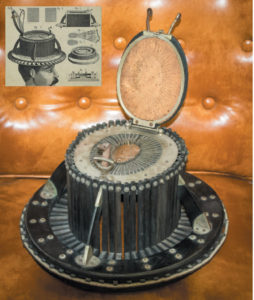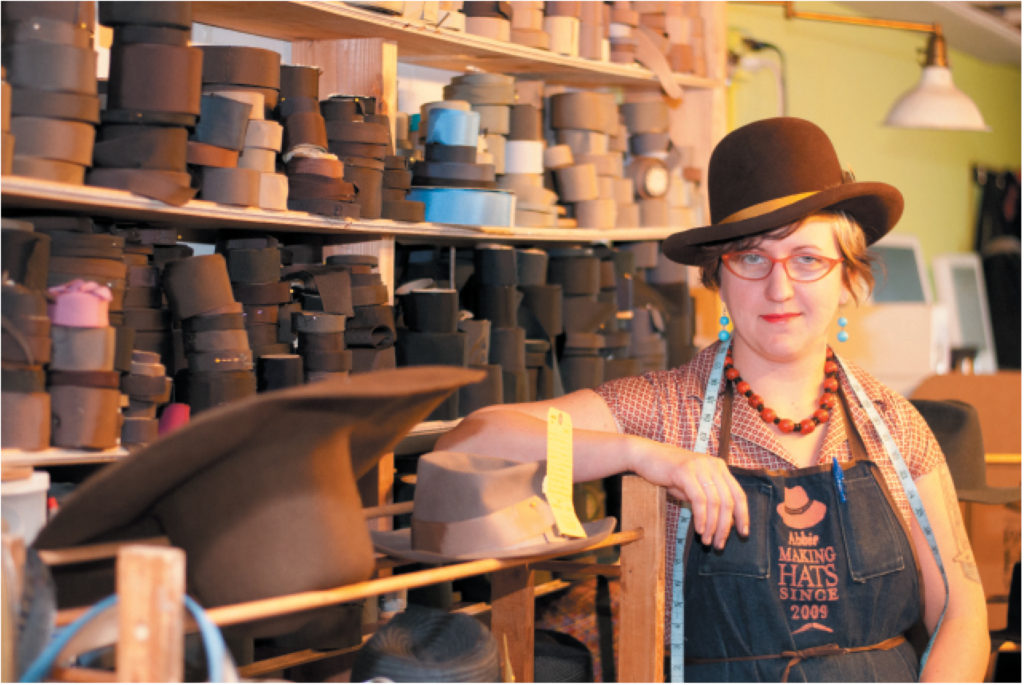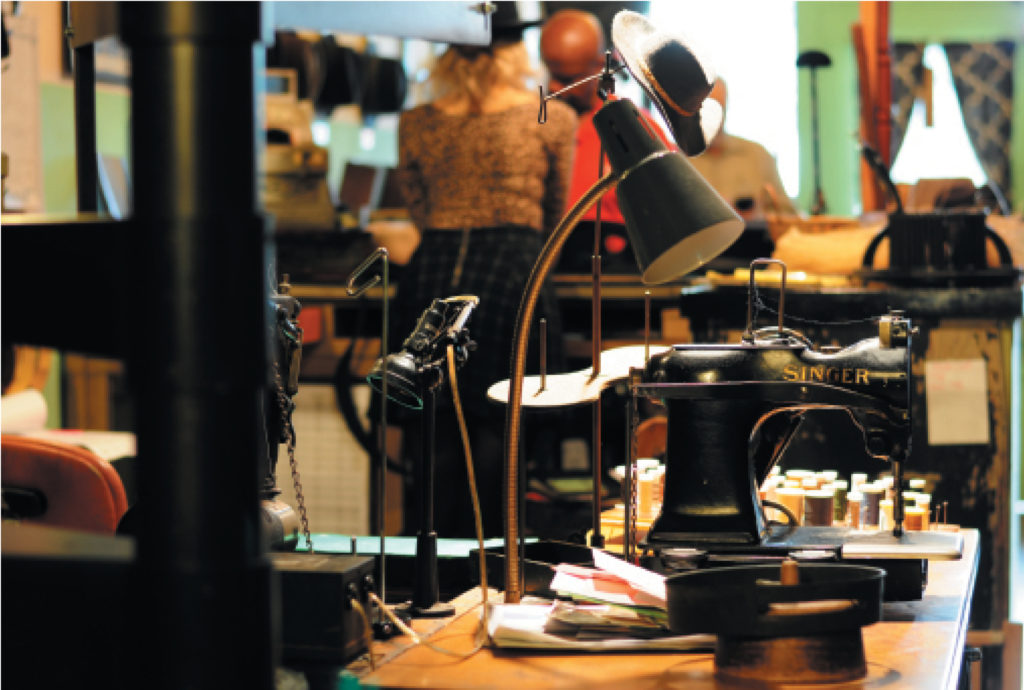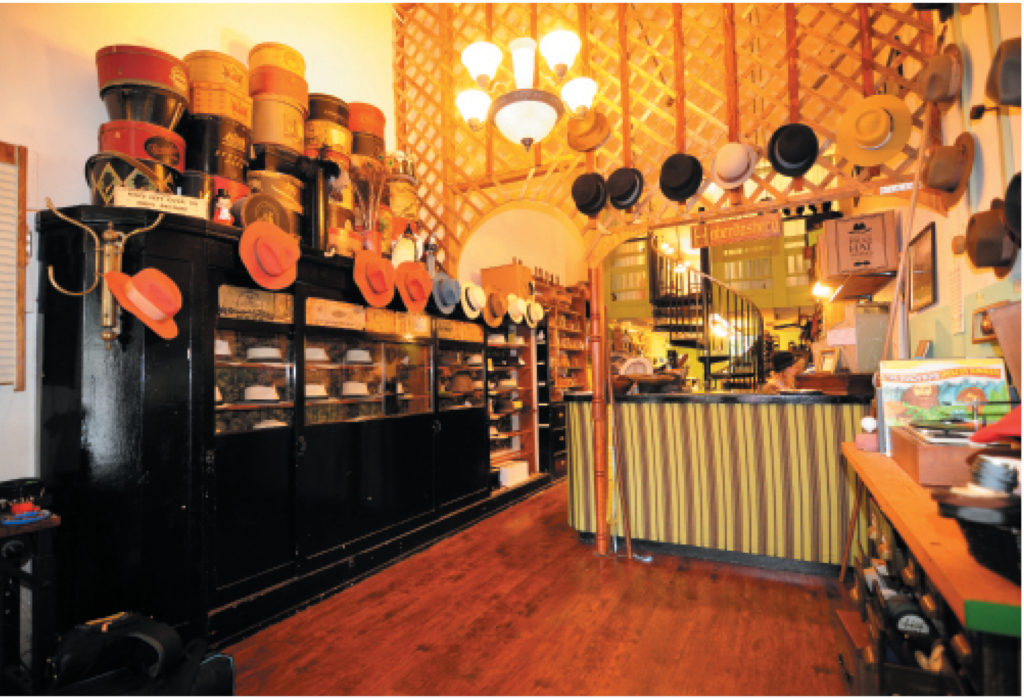
Back in 1980 when I arrived in San Francisco, I moved to a wonderful home built near the Palace of Legion of Honor in the Richmond District. It is a long established habit of mine, upon arriving in an unfamiliar place, to get to know my environs by journeying on foot because things are seen best measuring the landscape a yard at a time.
Among the places I came across was Paul’s Hatworks on Geary Boulevard. A small, old, and unpretentious shop, it begged further investigation and so I entered to see what treasures might be inside. What I found was a precious anachronism. A shop in which hats were custom crafted one noggin at a time since 1918 when it was founded by Napoleon Marquez. My excitement for this find was somewhat tempered upon discovery that the price of a fine hat began at $700.
I left the shop thinking that one day I would earn the privilege of a hat made there.
Many years later, as I was approaching a milestone birthday, I made up my mind that the time had come. Now residing in Silicon Valley, I drove about an hour north and arrived to park right in front of the shop. As I got out of my car, the front door of the shop opened and the proprietor emerged and turned to lock the door behind. Disappointed, thinking that he was closing for the day, I approached and explained that I had been waiting for years to order a hat and now had just driven up to see him. He looked at me resignedly and explained that he was not merely closing for the day but in fact was shutting the business down for good. Cheap hats from abroad combined with a lack of appreciation for hats in general had made the business unsustainable. Stunned and disappointed, I shook his hand and went away bewildered at my perfectly awful timing.

Ten years have passed since that day. In November of 2014, I found myself once again driving down Geary with a colleague. When we approached the block on which the Hatworks had been, I briefly told my story. As I pointed toward the old shop, I stopped mid-sentence for behold; Paul’s Hatworks was still there and quite obviously open for business. I was so surprised that I pulled into the nearest parking space to visit the shop and confirm what my eyes were seeing.
Michael Harris, the 3rd generation owner for 28 years, had made attempts at finding a successor over a period of years since the shop had officially closed, but had not been successful. One New Year’s day, he had apparently decided to open the door and ceremoniously close for the last and final time. Next door to the shop, in a small café, four young women had met to share breakfast that day and when they parted, one of them walked past the door of the hat shop and curiosity led her to enter. These young women had a long history of collaboration on creative ventures focused around theater productions, costume making, and other artistic pursuits. As this came out in discussion with Michael, a certain kismet was recognized and Michael declared that she and her group should apprentice and carry forward the tradition of hat making.
After a frenzy of calls and texts, the group convened that evening at supper and brainstormed the idea. With the help of copious advice both pro and con from friends and family, they determined to accept Michael’s proposal and enter apprenticeship as hat makers.
Paul’s Hatworks had now “Four Pauls” who operate the business. Every one a Hatter Extraordinaire, each takes a special role suited to her nature and talents. Olivia Griffin, “Barker”, is in charge of Public Relations and Marketing. Abbie Dwelle, “Tinkerer”, upkeeps the shops, machines, tools and maintains a keen eye on quality control. Wendy Hawkins, “Bean Counter”, is in charge of the numbers as well as logistics and scheduling. Kirsten Hove, “Sourcerer”, is in charge of sourcing the myriad parts and pieces required to fabricate their ultimate creations and special orders.

Now, a little over 6 years later, Paul’s Hatworks has a client list distinguished with names from local dignitaries Robert Mailer Anderson and author David Handler (Lemony Snicket), to President Obama!
I was thrilled to see the shop, busy with clients as I entered, and full of all types and varieties of hats in a setting which has changed very little since 1918. Everything in the interior of the shop hearkens back to days of local artisans and painstaking hand craftsmanship.
Partner Abbie Dwelle was there to greet and speak with me and from her I learned about the transition and rebirth of the business. I explained to her that I had been looking for a hat for years. I grew up in a time when a man who went hatless out of house, was considered eccentric and perhaps lunatic. In those days the ubiquitous hat came in all sorts of styles but the classic hats we see now mostly in old films are my favorite. Search as I may I could never find one to suit my taste.
Now in front of me I saw an assortment of beautiful hats which fit the bill perfectly. Why this shop had precisely the hat I was looking for is a very important fact. Lining the walls of the rear of the shop are shelves upon which rest an extensive inventory of carved wooden hat-forms dating back to the original founding and representing hat styles made since 1918. Top Hats, Bowlers, Pork Pie, Fedoras; a museum of hat fashions going back 97 years. I knew the time had come to order my hat and I asked Abbie to assist me in the process.

Abbie began her specific protocol for fitting a new client. She started asking a series of questions. Why did I want a hat? How would I use it? In what weather conditions and climate, and finally, what was my budget?
In response to my replies, Abbie brought out several examples of hats for me to try for style, material, and color.
The finest hats are made with 100% beaver fur. These hats have a stiffer more durable form, a smooth finish, and are hardiest in resisting rain. The prices for a fine beaver hat are in the neighborhood of $550 – $750 with some approaching $1,000. An alternative to the 100% beaver fur is a 100% rabbit fur hat. Beautiful and similar in finish to the beaver fur, these hats are slightly softer, have a softer finish, and are not as hardy in resisting rain. These hats begin in the mid-$300 range and up. One can also have a hat made with a Western Blend of 50/50 beaver and rabbit fur to combine the best attributes of each for a moderate price. For a more casual but elegant hat, one can choose “Feather-weight” beaver which is 100% beaver fur but a thinner and lighter weight. These are also in the moderate price range.
After some deliberation, I chose a hat style and color. Next came the ribbon choice. This decision is not merely the color and size of the ribbon but also what sort of decorative knot is preferred. A cushion, with various examples of knots attached, served as a pallet from which to choose. In consideration of the momentous nature of this purchase, I decided on the 100% beaver fur hat.

With all the variables decided, it was time now to begin the fitting. Abbie reached over to a workbench and brought out a contraption shaped like a top hat and, with its metal tubes and springs, appearing much like something from Dr. Frankenstein’s laboratory (please see front cover and page 36 for related photos). Abbie assured me that I was in no danger and that this device, the Conformateur along with its partner, the Formillion, was necessary to customize a template in the precise shape of my head.
That completed, Abbie fitted a hat band in the proper location around my head and all the components necessary to craft my hat were now complete. In approximately six to eight weeks I would be called for the final fitting of the completed hat.

With my receipt in hand, I now turned my attention to my next goal; the purchase of a Panama hat.
This is a deferred pleasure for a simple reason; a fine Panama hat ranges from many hundreds of dollars for a very nice hat to ten’s of thousands for dollars for the penultimate hat. The name “Panama Hat” is a misnomer for the fine straw hats actually woven in Ecuador. Periodically, it is necessary to travel to Montecristi and Cuenca, Ecuador to purchase new hat blanks from local weavers for the shop’s inventory. It is important that the straw blanks are purchased in person because the quality and cost of the blanks, as the raw hat form is called, relates to the material used and upon how finely and uniformly it is woven. There is no absolute standard for categorizing the quality since each weaver and each weaving is virtually unique. I was reminded of how fine Persian rugs are valued based upon the material, number of knots in the weaving, and the community in which they were woven. As I looked at hats with familiar textures and weave alongside their cousins which, in the

finest form, almost resemble silk fabric, I spotted one I particularly liked and upon inquiry Abbie informed me that I had recognized the most expensive hat in present inventory at $4,000. This hat was the finest Montecristi, meticulously woven from toquilla straw. Toquilla straw is split often to nearly the thickness of a thread allowing for the finest possible weave. The color and texture of the straw is affected by the seasons and weather among other things. Abbie reached for another beautiful hat made from Cuenca. Had I seen only this hat, I would have been dazzled by its fine quality. It is only when placed beside the Montecristi that one sees the markedly finer character which commands the dearest prices. Cuenca hats are quite affordable and the starting price ranges for a Montecristi are very much within a budget for a fine hat. Alas, my noggin will not likely feel the weight of a $4,000 Montecristi but after all, in the end it is what’s under the hat that matters most, or so I tell myself.





Be the first to comment